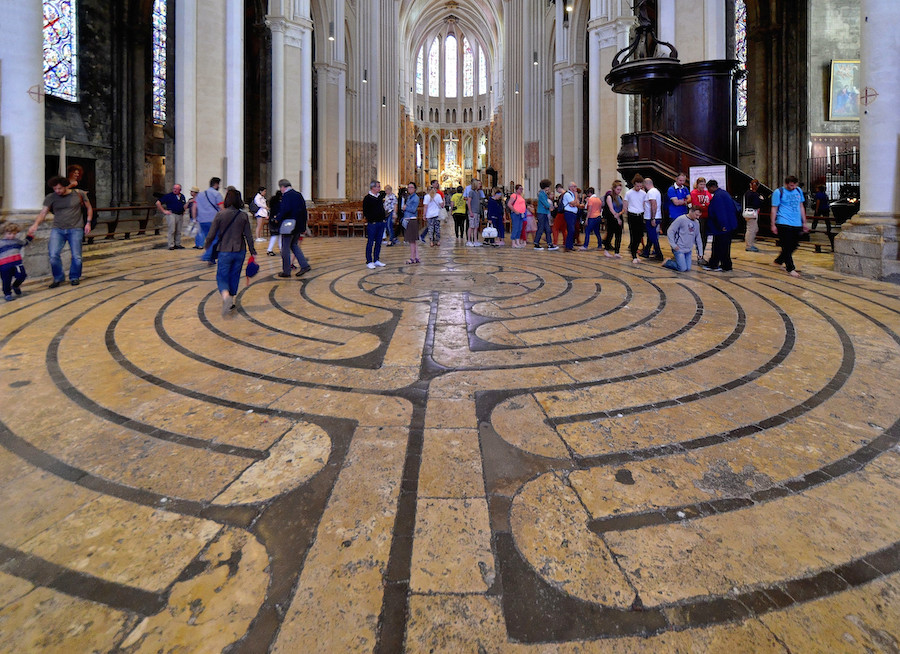Solvitur ambulando, “it is solved by walking,” St. Augustine is credited with saying. In prayer, much of Mainline Protestantism seems to have taken this maxim to heart, with churches expending significant space and funds to construct labyrinths: mandalic walking trails designed to promote meditative practice or spiritual healing.
Post-pandemic, the trend has grown beyond churches, with labyrinths now appearing at multifaith college campuses, community centers, and hospitals. The New York Post and the BBC have promoted labyrinth walking not as a spiritual discipline but as a tool for stress-relief.
The story of the labyrinth as a Christian symbol begins at the Chartres Cathedral, the floor of which has sported a labyrinth since the early 13th century, although proponents of the practice also cite Amerindian, Celtic, and Kabbalistic examples of labyrinth design. Touted as inspiration by the founders of the modern labyrinth movement, the Chartres labyrinth bears little resemblance to the “interspiritual” practices surrounding the movement today.
Thirteenth century pilgrims likely did walk through the labyrinth, but most knelt, using the structure as an opportunity for repentance. Sanctification, rather than self-actualization, was the original goal of the labyrinth, an emphasis entirely lost on the contemporary labyrinth movement.
The rector of Chartres Cathedral notes that the minotaur believed to have been featured at the center of the design represents Satan, with the entire design serving as a physical expression of salvation. As a 16th-century manuscript renders it, “This labyrinth shows exactly what this world is, wide for the one who enters, but narrower for the one who returns. Thus anyone who, captive of the world, weighed down by the weight of vices, can barely return.”
Labyrinths constructed across recent decades hardly communicate the redemptive spirit of the Chartres Cathedral or its medieval counterparts. This disconnect traces back to the founder of the modern labyrinth movement, Lauren Artress, a canon at San Francisco’s Grace Episcopal Cathedral, who built the cathedral’s labyrinth in the early 1990s.
Artress claims to have “rediscovered” labyrinth-walking after clearing the chairs from the Chartres Cathedral, which previously obscured the design. Artress admits that there is no historical evidence of the labyrinth-walking practice she popularized, but in her New Age historiography, this is attributed to “teachings… hidden by ancient teachers to be discovered at the right moment.”
Rather than harmonizing her innovative spiritual technology with the Christian history of the labyrinth symbol, Artress has always staffed her movement with esotericists. Cited as inspiration for the foundation of her organization, Veriditas, are shamans, geomancers, and former U.S. Secretary of State Hillary Clinton. Ironically, geomancy was condemned by the late medieval Church less than a decade after the inlaying of the labyrinth at the Chartres Cathedral.
New Age spirituality associated with the labyrinth movement continues to the present in Veriditas. Just next month, Veriditas will hold an event to honor “our journey from ‘good’ to ‘better,'” a Pelagian formula entirely at odds with the traditional Christian understanding of sin and redemption. Curiously, “making good men better” is also a common motto in Freemasonry.
Regardless of its unchristian origins, the labyrinth movement has been popular among progressive churches, with even some of the most iconic Mainline Protestant churches sporting the installations as permanent or temporary spiritual disciplines. Not all these expressions have been negative; most faithful churches functionally use their labyrinths as ambulatory supplements to otherwise devout meditative prayer.
Nevertheless, the growth of labyrinths has opened churches up to further secularization and liberalization. The occult and perennialist roots of modern labyrinth practice make them easy entry points for heterodoxy. At the Washington National Cathedral, their “labyrinth coordinator” instructs practitioners to pray to God or the Universe while walking the labyrinth, with Christianity left to a matter of personal taste.
The vague pantheistic worldview promoted by many labyrinth proponents explains well why the growth of labyrinths in churches has stalled out, and their construction in the secular world has only increased. The labyrinth’s noncommittal self-improvement spirituality is a fine choice for institutions looking to accommodate a “spiritual-but-not-religious” public, like universities, public parks, and rehabilitation centers.
The purpose of labyrinths in the Christian tradition was always to draw attention to the reality of evil and the saving power of Christ. Modern labyrinth walking indicates an aimless, amorphous spirituality suitable for a county library but not for a church. For churches looking to incorporate new spiritual practices, delving into the millennia-long deposit of faith is more appropriate than moving furniture around looking for secret wisdom.






Comment by David on July 22, 2024 at 8:47 am
There are two general types of labyrinths. In the first, making a wrong turn can lead to a dead end. The second is more “universalist” where everyone ends in the same place regardless of the turns one makes. The Chartres example is of the second. The cathedral’s website has a long paper on its history and use. It makes mention of an Easter dance and a sort of ball game.
https://www.cathedrale-chartres.org/cathedrale/monument/le-labyrinthe/le-labyrinthe-enfin-devoile/
Comment by Curtis Nester on July 22, 2024 at 2:37 pm
How do you walk a labyrinth while on your knees, the best way to pray?
Comment by Diane on July 22, 2024 at 3:24 pm
Sounds like someone got up on the wrong side of the bed before writing this piece.
Comment by David Gingrich on August 3, 2024 at 5:40 am
It is solved by following Jesus.
Comment by Karen Joy on August 12, 2024 at 10:23 am
The modern attitude of labyrinths is pretty much their attitude on all things mystical and Godly — they completely miss the point. As the author said, self-actualization, rather than sanctification. And they couldn’t begin to tell you the difference.
I read a comment somewhere else that explained it beautifully. Since they won’t acknowledge God and his Truth, they become their own truth, but then that means they have no absolute truth outside of themselves, thus their “truth” can waver depending on today’s mood or current hunger pangs.